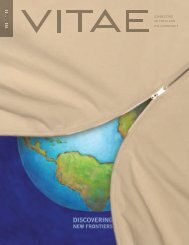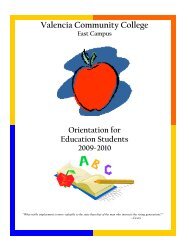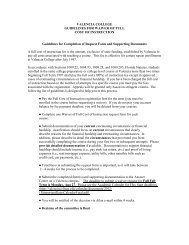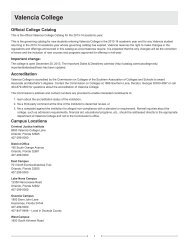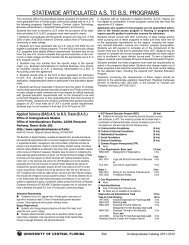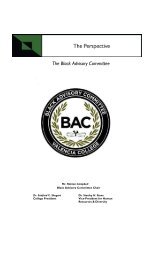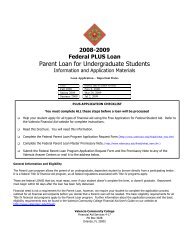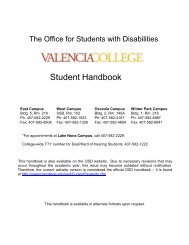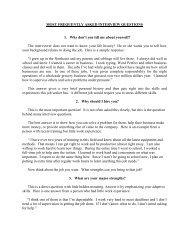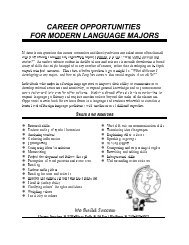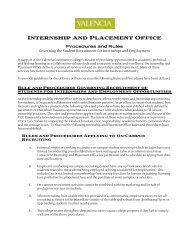MLA Paper Format - Valencia College
MLA Paper Format - Valencia College
MLA Paper Format - Valencia College
Create successful ePaper yourself
Turn your PDF publications into a flip-book with our unique Google optimized e-Paper software.
How to Set Up Standard <strong>MLA</strong> <strong>Format</strong> in Microsoft Word<br />
and WordPerfect<br />
Font Type and Size<br />
Choose an easily readable font (e.g. Times New Roman) and size (12 pt.)<br />
In Microsoft Word and WordPerfect<br />
Go to the <strong>Format</strong> menu > Font<br />
• Font should be set to Times New Roman.<br />
• Font Size should be set to 12 point.<br />
Margins<br />
Do not justify the right margin of your paper. It may look “neat and clean” but it is not<br />
<strong>MLA</strong> <strong>Format</strong><br />
In Microsoft Word<br />
Go to the File menu > Page Setup<br />
• Margins should be set to 1” on the top, bottom, left, and right.<br />
In Word Perfect<br />
Go to File > Page Set-Up > Click on Margins and Layout Tab><br />
• Make sure all margins read one inch. It should already be done for you.<br />
Spacing<br />
Your paper should be double spaced throughout, including block quotes. Leave one space<br />
after a period unless your professor prefers two spaces.<br />
In Microsoft Word<br />
Go to the <strong>Format</strong> menu > Paragraph<br />
• Line spacing should be set to “double.”<br />
In Word Perfect<br />
Go to <strong>Format</strong> > Line > Spacing ><br />
• In the spacing box delete “1.0” and replace with “2.0”
Headings, Page Numbers, and Titles<br />
Research papers in <strong>MLA</strong> do not include a title page, unless otherwise specified by your<br />
instructor. One inch from the top, include the following information:<br />
1. Your name<br />
2. Your instructor’s name<br />
3. The course you are writing for<br />
4. The date<br />
5. Double space once and then include your title<br />
NOTE: Use only regular, 12 point font in titles and center them. Do not use bold-faced type or other<br />
special settings.<br />
Header should be set to 0.5” from the top. The header is where you will place your page<br />
numbers. Do not put your page numbers inside the 1” margin.<br />
In Microsoft Word<br />
Header and Footer Page Numbers<br />
Go to the View menu > Header and Footer<br />
Go to the Insert menu > Page Numbers<br />
• Type your last name and make sure it is set to<br />
• The numbering should be set to “Top of<br />
“align right.”<br />
page” and “Alignment right.”<br />
In Word Perfect<br />
Header and Footer Page Numbers<br />
Go to Insert > Header and Footer > Click Create > Go to <strong>Format</strong> > Page > Numbering > Click the<br />
• Select “right alignment”.<br />
position box<br />
• Type your last name. Close header box.<br />
• Click on Top Right<br />
• Click on the “1” in the Page numbering<br />
format.<br />
Where Can I Get Help with <strong>MLA</strong>?<br />
The <strong>MLA</strong> Handbook for Writers of Research <strong>Paper</strong>s, 6 th ed.<br />
The Penguin Handbook<br />
Troyka Quick Access<br />
Basics: A Handbook<br />
Winter Park Campus Library Website<br />
o By selecting the “Online Databases and Articles” link from “Research Tools”, you gain<br />
access to detailed, color coded examples for each of the databases you use for this<br />
paper (these examples are found under “documentation”)
www.citationmachine.net<br />
o Don’t feel like building your own citations? Visit citationmachine.net, plug in information<br />
about your source and then copy and paste the program’s example.<br />
Talitha Benjamin<br />
Professor Obermeier<br />
English 200<br />
8 December 1999<br />
Perceptual Manipulation in Shakespeare's Taming of the Shrew<br />
Benjamin 1<br />
Teun A. Van Dijk, in his essay "Pragmatics and Poetics," explains the reason for speech<br />
is "to change the internal state of the hearer" (Dijk 30). Ferdinand de Saussure describes in his<br />
essay, "Nature of the Linguistic Sign," how a word is more connected to the minds of the speaker<br />
and the hearer than to anything else. He describes that the "linguistic sign" as a unit formed<br />
equally by the association of a "concept" and a "sound-image." The "sound-image" is what one<br />
would call a spoken word, something that "signifies." Saussure describes it as "the psychological<br />
imprint of the sound, the impression that it makes on our senses" (Saussure 832). He goes on to<br />
describe its materiality: "the sound-image is sensory" (Saussure 832). The term "concept" is<br />
summed-up as being "generally more abstract" (Saussure 833) than the "sound-image." The<br />
"concept," it appears, is what one would call objective perceptions, for example, the table, or an<br />
ox. A "concept" is anything that can be "signified." In The Taming of the Shrew Petruchio<br />
intends to break Katharina by disassociating her from her sense of reality by prying apart the<br />
linguistic unit she has intuitively taken for granted.<br />
The first scene demonstrates Katharina's personality through the interaction she has with<br />
her sister, Bianca, and her father, Baptista. She is shown to have "a devilish spirit" (Shakespeare<br />
2.1, 25). Petruchio, shortly afterwards, meets Baptista and speaks to him about Katharina.<br />
Instead of calling her a shrew, Petruchio compliments her on her "beauty and her wit, / Her<br />
affability and bashful modesty, / Her wonderous qualities and mild behavior" (Shakespeare 2.1,
<strong>MLA</strong> Works Cited Page <strong>Format</strong><br />
The Works Cited page follows the last page of your paper and is numbered sequentially.<br />
The title of your Works Cited page goes 1” from the top margin and is not bold, italicized, underlined or in<br />
quotes<br />
Your first entry, alphabetized by author’s last name or first major word of the title, begins at the left margin,<br />
two lines below the title.<br />
The first line of each citation is at the left margin. Each additional line takes a ½ inch hanging indention from<br />
the left margin.<br />
The ENTIRE Works Cited page is double-spaced with 1” margins<br />
1”<br />
Hanging Indent<br />
In Microsoft Word<br />
Go to the <strong>Format</strong> menu > Paragraph<br />
• Line spacing should be set to “double,”<br />
• Indentation should be set to “hanging” under the “Special” dropdown<br />
menu.<br />
Works Cited<br />
In Word Perfect<br />
Select <strong>Format</strong> > Paragraph > Hanging Indent<br />
Ojeda 1<br />
Anderson, J. "Keats in Harlem." New Republic 204.14 (8 Apr. 1991): n. pag. Online. EBSCO. 29<br />
Dec. 1996.<br />
Burka, Lauren P. "A Hypertext History of Multi-User Dimensions." MUD History. 5 Dec. 1994<br />
.<br />
Creation vs. Evolution: "Battle of the Classroom." Videocassette. Dir. Ryall Wilson, PBS Video,<br />
1982. (<strong>MLA</strong>) 58 min.<br />
Hennessy, Margot C. "Listening to the Secret Mother: Reading J.E. Wideman's Brothers and<br />
Keepers." American Women's Autobiography: Fea(s)ts of Memory. Ed. Margo Culley.<br />
Madison, WI: U. Wisconsin P, 1992. 302-314.<br />
"Money." Compton's Precyclopedia. 1977 ed., X, 80-91.<br />
Mumford, Lewis. The Highway and the City. New York: Harcourt Brace and World, 1963.<br />
- - -. Highways Around the World. New York: Prentice, 1967.<br />
Orchestra. CD-ROM. Burbank: Warner New Media. 1992.<br />
"The Political Problems of Arms-Treaty Verification." Technology Review May/June 1986: 34-<br />
47.<br />
Hanging indent.<br />
Microsoft Word Path:<br />
<strong>Format</strong>: Paragraph:<br />
Indentation: Special:<br />
Hanging Indent<br />
Redford, Robert. Personal Interview. 24 Sept. 1996.<br />
Schneider, Pamela. Interview. Seniors: What Keeps Us Going. With Linda Storrow. Natl. Public<br />
Radio. WNYC. New York. 11 July 1988.<br />
Sixty Minutes. CBS. WFSB, Hartford. 3 May 1991.<br />
U.S. Dept. of Commerce. U.S. Industrial Outlook. Washington, D.C., Government Printing<br />
Office, 1990.<br />
Williams, Larry. "Powerful Urban Drama Builds in Bell's Tense 'Ten Indians'." Rev. of Ten<br />
Indians, by Madison Smartt Bell. Hartford Courant 1 Dec. 1996: G3.<br />
1”<br />
½”<br />
Where Can I Get Help with <strong>MLA</strong>?<br />
The <strong>MLA</strong> Handbook for Writers of Research<br />
<strong>Paper</strong>s, 6 th<br />
ed.<br />
The Penguin Handbook<br />
Troyka Quick Access<br />
Basics: A Handbook<br />
Winter Park Campus Library Website<br />
o By selecting the “Online Databases and<br />
Articles” link from “Research Tools”, you<br />
gain access to detailed, color coded<br />
examples for each of the databases you<br />
use for this paper (these examples are<br />
found under “documentation”)<br />
www.citationmachine.net<br />
o Don’t feel like building your own citations?<br />
Visit citationmachine.net, plug in<br />
information about your source and then<br />
copy and paste the program’s example.




